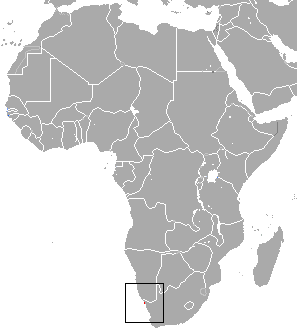De Winton's golden mole facts for kids
Quick facts for kids De Winton's golden mole |
|
|---|---|
 |
|
| Conservation status | |
| Scientific classification | |
| Genus: |
Cryptochloris
|
| Species: |
wintoni
|
 |
|
| De Winton's golden mole range | |
| Synonyms | |
|
Cryptochloris zyli wintoni |
|
The De Winton's golden mole (Cryptochloris wintoni) is a small, rare mammal that lives only in South Africa. It belongs to a family of animals called Chrysochloridae, which are known for their shiny fur. This mole makes its home in dry shrubland, sandy areas, and along the coast.
For a long time, this special mole was thought to be lost. After being seen in 1937, it was not observed again for over 86 years! But in 2023, scientists found it again, which was very exciting news. Sadly, its home is being destroyed, and it is listed as "critically endangered". The mole is named after William Edward de Winton, a British zoologist.
Contents
What is De Winton's Golden Mole?
De Winton's golden mole is a fascinating creature that spends most of its life underground. It is part of a group of animals called golden moles, which are not true moles but look very similar. They are known for their unique, shimmering fur that can look golden.
What Does It Look Like?
This golden mole looks a lot like another species called Grant's golden mole. Its fur on top is short and thick, appearing slate-grey with a hint of yellow. Each hair has a grey base, a whitish middle, and fawn-colored tips. Its face, cheeks, and lips have a stronger yellow color. The fur on its belly is lighter than on its back.
Its front paws are specially made for digging. The claw on its third toe is about 10.5 millimeters (0.41 inches) long and 4 millimeters (0.16 inches) wide. The other claws are a bit shorter, forming a sharp tool for digging through sand.
Where Does It Live?
De Winton's golden mole is found in specific sandy areas along the coast of South Africa. The main place it was known to live is near a town called Port Nolloth. These moles prefer coastal sand dunes and other sandy spots nearby.
Why Is It Special?
The rediscovery of De Winton's golden mole is a big deal for scientists and conservationists. For many years, it was one of the "most wanted lost" species in the world.
The Search for Lost Species
In 2017, the organization Re:wild added De Winton's golden mole to its list of 25 "most wanted lost" species. This meant that scientists were actively looking for it, hoping to find signs that it still existed. The last confirmed sighting was in 1937, making it a true mystery for decades.
How Was It Found Again?
Scientists used clever methods to find the mole again in 2023. They collected samples of environmental DNA (eDNA) from the sand. This eDNA is genetic material that animals leave behind, like skin cells or waste. They also looked for traces of burrows and even used sniffer dogs trained to find golden moles.
The findings showed that a healthy group of De Winton's golden moles was living in the area. The eDNA evidence also suggested that the species might live in a much wider area than first thought. It was found from Port Nolloth all the way south to Lambert's Bay.
Is It Still in Danger?
Even though De Winton's golden mole has been rediscovered, it is still considered to be in great danger.
What Threats Does It Face?
The main threat to this mole is the destruction of its habitat. Mining for diamonds near Port Nolloth is a big problem because it destroys the sandy areas where the moles live. Even though it might live in a wider area, it is still thought to be very rare.
What Does "Critically Endangered" Mean?
The International Union for Conservation of Nature (IUCN) lists De Winton's golden mole as "critically endangered". This is the highest level of threat before a species is considered extinct in the wild. It means the species faces an extremely high risk of dying out very soon.
Studying golden moles is hard because they live underground. Their rarity and how much they look like other golden moles make them even harder to observe and protect.


